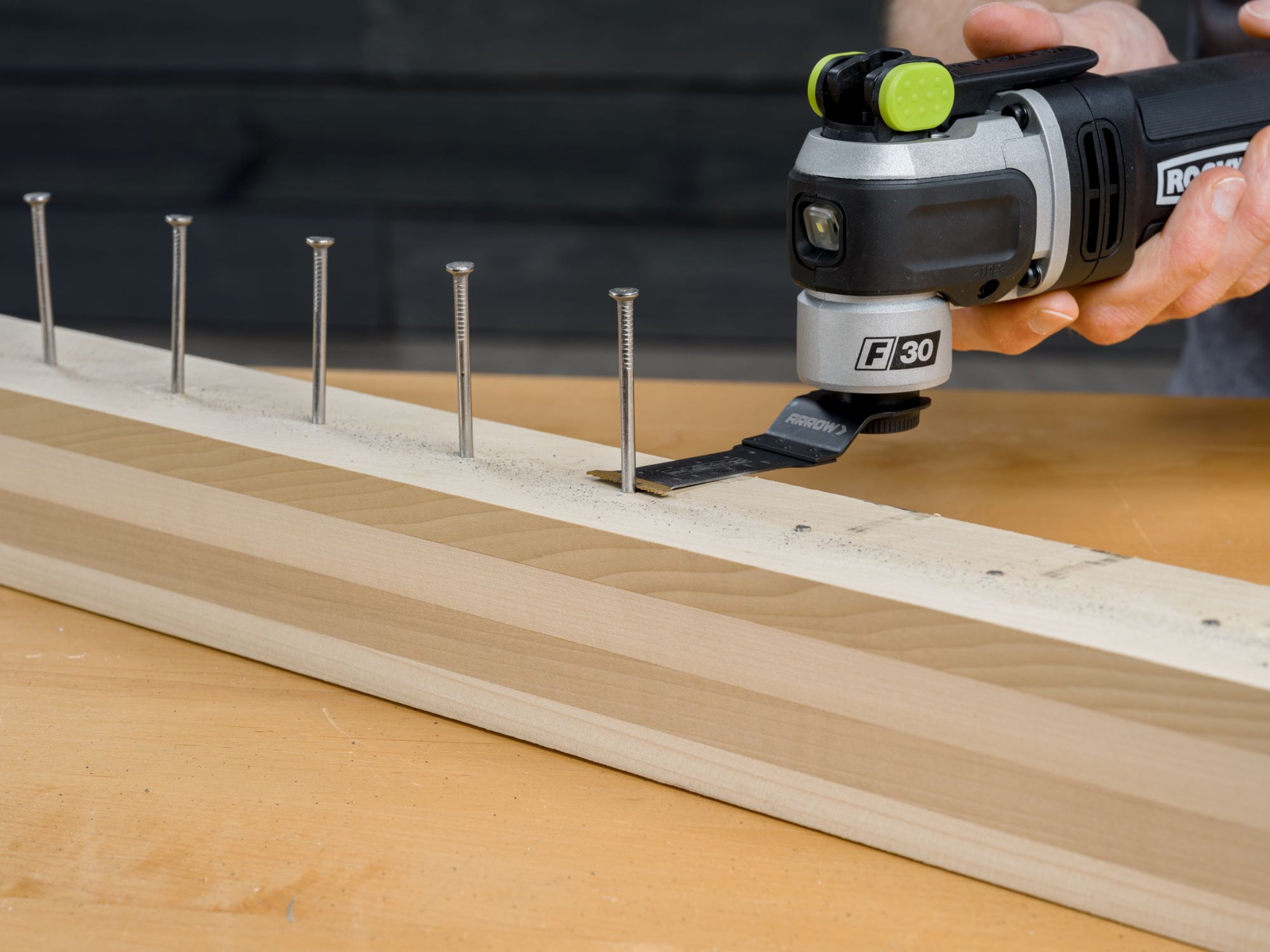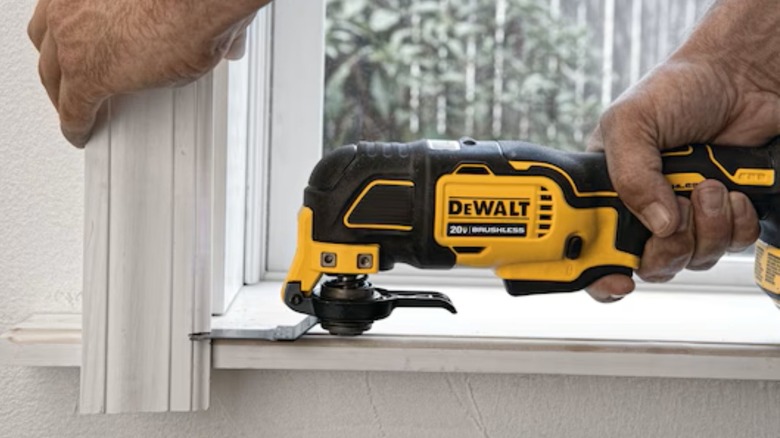Have you ever faced a small wood-cutting job and wondered if your oscillating tool could handle it? You might be surprised how versatile this handy device really is.
If you’re looking for a quick, precise way to cut wood without hauling out bigger, bulkier saws, understanding how to use your oscillating tool effectively can save you time and effort. Keep reading to discover exactly what types of wood cuts you can achieve, the best blades to use, and tips to get clean, accurate results every time.
This knowledge could change the way you tackle your next project.

Credit: arrowtoolgroup.com
Oscillating Tool Basics
Oscillating tools are versatile power tools used for many tasks. They work by moving the blade back and forth quickly.
This quick movement allows for precise cuts in wood and other materials. Many people ask if you can cut wood with these tools.
How Oscillating Tools Work
Oscillating tools use a small blade or accessory that moves in a rapid side-to-side motion. The angle of this motion is very small, usually less than 5 degrees.
This motion helps control the cut and reduces vibration. It works well for detailed work and small cuts in wood, metal, and plastic.
- The motor powers the blade to oscillate quickly.
- The blade’s rapid motion cuts or sands the material.
- Users can change blades for different tasks.
- Speed can often be adjusted for better control.
- The tool is handheld and easy to maneuver.
Common Accessories For Wood Cutting
Different blades and attachments help the tool cut wood in many ways. Choosing the right accessory is important for clean cuts.
| Accessory | Use | Best For |
| Wood Cutting Blade | Straight cuts in wood | Thin and thick wood pieces |
| Segmented Blade | Flush cuts and plunge cuts | Hard-to-reach areas |
| Carbide Blade | Cutting hardwood and nails | Dense or mixed materials |
| Sanding Pad | Sanding wood surfaces | Smooth finishing |
Cutting Wood With An Oscillating Tool
An oscillating tool is versatile and can cut wood in many ways. It works by moving the blade side to side rapidly. This helps make precise cuts in tight spaces.
Many wood types can be cut using this tool. Choosing the right blade and method makes the job easier and safer.
Types Of Wood Suitable For Cutting
Not all wood is easy to cut with an oscillating tool. Softwoods and thin pieces work best. Hardwoods need more care and the right blade.
- Softwoods like pine and cedar are good choices
- Plywood and MDF can be cut cleanly
- Thin hardwoods such as oak or maple are possible but slow
- Very thick or dense wood may cause blade wear
Best Blades For Wood
Choosing the right blade helps to cut wood smoothly. Blades vary by tooth shape, size, and material.
| Blade Type | Best For | Key Feature |
| Bi-metal blades | General wood cutting | Durable and sharp |
| Carbide grit blades | Hard and abrasive woods | Long-lasting edge |
| Segmented blades | Fast rough cuts | Wide tooth gaps |
| Precision blades | Fine detailed cuts | Thin and narrow |
Cutting Techniques To Try
Using the right technique improves safety and cut quality. Take your time and keep the tool steady.
- Start with a slow speed to control the cut
- Use a guide or straight edge for straight cuts
- Cut in small sections for thick wood
- Keep the blade perpendicular to the wood surface
- Wear safety glasses and hold the wood firmly
Advantages Of Using An Oscillating Tool
An oscillating tool is handy for cutting wood in many projects. It offers benefits that make woodworking easier and more precise.
This tool works by moving its blade back and forth very fast. This action helps cut wood with less effort and more control.
Precision And Control
An oscillating tool gives users great precision when cutting wood. It can reach tight spaces and make detailed cuts.
- Allows straight and curved cuts
- Reduces risk of slipping or damaging wood
- Easy to handle for small, detailed work
- Ideal for plunge cuts without removing large sections
Versatility In Woodworking
This tool can do many tasks beyond cutting wood. It works well on different materials and shapes.
| Task | Tool Advantage |
|---|---|
| Cutting wood | Precise and clean cuts in tight spots |
| Sanding edges | Can sand small, detailed areas easily |
| Scraping paint | Removes paint without damaging wood |
| Removing grout | Accesses narrow spaces with ease |

Credit: www.slashgear.com
Limitations To Consider
Cutting wood with an oscillating tool is possible but comes with limits. These limits affect how well the tool works and the quality of the cut.
Knowing these limits helps you avoid problems and get better results when using the tool on wood.
Depth And Speed Restrictions
Oscillating tools cut by moving back and forth very fast. They do not spin like saws. This limits how deep and fast they can cut wood.
The blade on an oscillating tool is usually short. It can only cut through thin wood pieces in one pass. Cutting deeper wood takes many passes.
- Maximum cut depth is usually less than 1 inch.
- Cutting too fast can burn the wood or dull the blade.
- Slower speed gives cleaner cuts but takes longer.
- Oscillating tools work best for small, shallow cuts.
Material Thickness Challenges
Thick wood is hard to cut with an oscillating tool. The tool’s small blade cannot easily pass through thick wood in one go.
Trying to cut thick wood can cause the tool to overheat or wear out quickly. You may need other tools for thick wood cutting jobs.
- Thick wood may need multiple passes to cut through.
- Repeated cutting can damage the blade or tool.
- Oscillating tools are better for thin or soft wood.
- For thick or hardwood, use a saw designed for deep cuts.
Safety Tips For Wood Cutting
Cutting wood with an oscillating tool can be efficient. It’s important to follow safety measures to prevent accidents.
Here are some essential safety tips to ensure you work safely and effectively.
Protective Gear Essentials
Wearing the right gear is crucial for your safety. It protects you from dust and sharp objects.
- Wear safety goggles to protect your eyes.
- Use ear protection to prevent hearing damage.
- Wear gloves to keep your hands safe from cuts.
- Use a dust mask to avoid inhaling wood particles.
Proper Handling And Maintenance
Handling and maintaining your oscillating tool properly ensures its longevity. It also makes cutting safer.
Follow these tips for better handling and care.
- Always check the tool for damage before use.
- Keep the blade sharp for clean cuts.
- Use both hands for a steady grip.
- Regularly clean the tool to prevent dust buildup.
- Store the tool in a dry place to avoid rust.
Expert Tips For Best Results
Cutting wood with an oscillating tool is possible and useful for small jobs. This tool can make precise cuts in wood.
Using the right techniques will help you get clean and accurate cuts. Follow these tips for better results.
Blade Selection Guide
Choosing the right blade is key for cutting wood well with an oscillating tool. Different blades work for different wood types.
Look for blades marked for wood cutting. Blades with teeth work best on soft and hard wood.
- Use wood-specific blades for clean cuts
- Choose bi-metal blades for durability
- Select blade size based on the cut depth
- Fine-tooth blades give smoother finishes
Optimizing Cutting Angles
Hold the tool steady and keep the blade at the right angle. This helps you cut wood evenly and avoid damage.
Start cutting at a shallow angle and increase it as needed. Avoid pushing too hard to keep control.
- Hold the tool perpendicular to the wood surface
- Use slow, steady movements for clean cuts
- Adjust angle slightly for curved or angled cuts
- Let the tool do the work, avoid forcing
Maintaining Tool Performance
Keep your oscillating tool in good shape for the best cutting results. Clean and check it regularly.
Replace blades when dull. Lubricate moving parts to avoid wear. Proper care extends tool life and cutting quality.
- Clean sawdust and debris after each use
- Check blade tightness before cutting
- Replace dull or damaged blades promptly
- Lubricate moving parts as per manual instructions

Credit: www.yahoo.com
Frequently Asked Questions
Can An Oscillating Tool Cut Wood Effectively?
Yes, an oscillating tool can cut wood effectively. It works best for small, precise cuts and detail work. Using the right blade improves cutting speed and accuracy. It’s ideal for trimming, plunge cuts, and flush cuts on wood.
What Type Of Blades Cut Wood With An Oscillating Tool?
Bi-metal or carbide blades are best for cutting wood. These blades offer durability and clean cuts. Choose a blade designed specifically for wood to ensure optimal performance. Avoid metal-cutting blades for wood to prevent rough edges.
Is An Oscillating Tool Suitable For Thick Wood Cutting?
Oscillating tools are not ideal for thick wood cutting. They excel at shallow, precise cuts but struggle with deep cuts. For thick wood, use a saw like a circular or jigsaw. Oscillating tools are better for trimming and detail tasks.
How To Improve Wood Cutting Performance With An Oscillating Tool?
Use sharp, wood-specific blades for better cutting performance. Maintain a steady hand and apply moderate pressure. Keep the tool perpendicular to the wood surface. Regularly check blade condition to avoid slow or rough cuts.
Conclusion
Oscillating tools can cut wood, but they work best on small projects. They offer control for detailed cuts and tight spaces. Choose the right blade for clean cuts. Always wear safety gear and work slowly. This tool is handy but not for big jobs.
Keep your tool sharp and steady for better results. Give it a try for quick wood cuts around your home.


